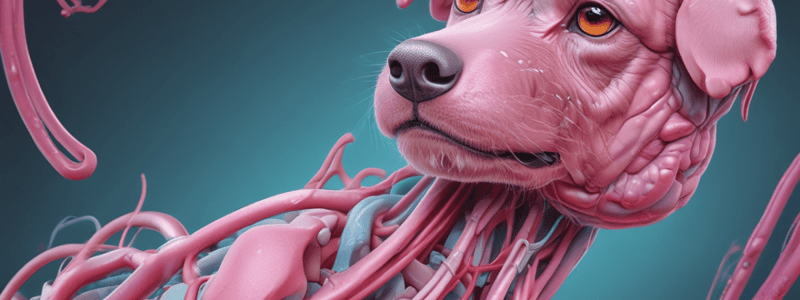Podcast
Questions and Answers
¿Cuál de las siguientes es una causa común de infecciones del tracto urinario en perros?
¿Cuál de las siguientes es una causa común de infecciones del tracto urinario en perros?
- Hiperactividad física
- Deficiencia de vitamina C
- Exposición a químicos tóxicos
- Predisposición genética (correct)
¿Qué trastorno reproductivo en gatos se caracteriza por la retención de testículos en el abdomen?
¿Qué trastorno reproductivo en gatos se caracteriza por la retención de testículos en el abdomen?
- Cirrosis hepática
- Osteoporosis
- Cryptorchidism (correct)
- Estrabismo
¿Cuál de las siguientes pruebas es menos útil para diagnosticar problemas del sistema genitourinario en animales?
¿Cuál de las siguientes pruebas es menos útil para diagnosticar problemas del sistema genitourinario en animales?
- Endoscopia
- Análisis de sangre
- Electrocardiograma (correct)
- Radiografía
¿Cuál es un síntoma común de urolitiasis en animales?
¿Cuál es un síntoma común de urolitiasis en animales?
¿Cuál de las siguientes no es una opción de tratamiento común para trastornos genitourinarios en animales?
¿Cuál de las siguientes no es una opción de tratamiento común para trastornos genitourinarios en animales?
¿Qué método de diagnóstico es más adecuado para visualizar la presencia de cálculos en el tracto urinario de un animal?
¿Qué método de diagnóstico es más adecuado para visualizar la presencia de cálculos en el tracto urinario de un animal?
¿Cuál de las siguientes afirmaciones es correcta con respecto a los síntomas comunes del sistema genitourinario?
¿Cuál de las siguientes afirmaciones es correcta con respecto a los síntomas comunes del sistema genitourinario?
¿Cuál de las siguientes opciones NO es un tratamiento común para las afecciones genitourinarias?
¿Cuál de las siguientes opciones NO es un tratamiento común para las afecciones genitourinarias?
¿Cuál de las siguientes afirmaciones es FALSA con respecto a los métodos de diagnóstico para los problemas genitourinarios?
¿Cuál de las siguientes afirmaciones es FALSA con respecto a los métodos de diagnóstico para los problemas genitourinarios?
Según el texto, ¿cuál de las siguientes afirmaciones es VERDADERA sobre el tratamiento de las afecciones genitourinarias?
Según el texto, ¿cuál de las siguientes afirmaciones es VERDADERA sobre el tratamiento de las afecciones genitourinarias?
¿Cuál de las siguientes opciones NO se menciona como un síntoma común de los trastornos genitourinarios?
¿Cuál de las siguientes opciones NO se menciona como un síntoma común de los trastornos genitourinarios?
Según el texto, ¿cuál de las siguientes afirmaciones es FALSA sobre el papel de la semiótica veterinaria en los trastornos genitourinarios?
Según el texto, ¿cuál de las siguientes afirmaciones es FALSA sobre el papel de la semiótica veterinaria en los trastornos genitourinarios?
Study Notes
Veterinary Semiotics: Genitourinary System
Overview
The veterinary semiotic approach involves understanding animal behavior and physiology to identify signs of illness and health status. This approach is particularly useful in the study of the genitourinary system, where both urinary and reproductive functions play essential roles in overall health. This article will discuss the semiotics of the genitourinary system in animals, focusing on common disorders, diagnostic methods, treatment options, and symptoms.
Urinary System Disorders
Disorders affecting the urinary system in animals include urinary tract infections (UTIs), pyelonephritis, and urolithiasis. These conditions can lead to inflammation, damage to the renal tissue, or even renal failure if left untreated. Dogs are prone to these diseases due to factors such as environmental exposure and specific breed traits.
Reproductive System Disorders
Reproductive system disorders in animals can range from hormonal imbalances to structural abnormalities leading to infertility. Some examples include XX sex reversal in dogs, cryptorchidism in cats, and some transmissible venereal tumors. These disorders can cause problems with conception, gestation, and delivery.
Diagnostic Methods for Genitourinary Issues
Diagnosing issues related to the genitourinary system relies on several methods, including physical examination, urinalysis, blood tests, imaging techniques like radiography and ultrasound, endoscopy, and histopathology. Each method offers unique insights into the patient's condition, allowing veterinarians to formulate appropriate treatments.
Common Symptoms in the Genitourinary System
Symptoms typical of genitourinary issues include leaking urine, difficulty walking, frequent urination, blood in the urine, unusual vocalizations, and decreased appetite. Additionally, animals exhibiting abnormal behaviors, excessive grooming, or changes in temperature might be experiencing underlying reproductive system problems.
Treatment Options for Genitourinary Conditions
Treatments for genitourinary conditions vary depending on the severity and nature of the issue. Antimicrobials, anti-inflammatory drugs, fluid management, surgical intervention, and lifestyle adjustments are among the approaches taken to alleviate inflammation, pain, or promote healing.
In conclusion, veterinary semiotics plays a crucial role in identifying and understanding disorders concerning the genitourinary system in animals. By anticipating and recognizing signs of distress, veterinarians can intervene promptly and effectively, ensuring optimal health outcomes for our furry friends.
Studying That Suits You
Use AI to generate personalized quizzes and flashcards to suit your learning preferences.
Description
Explora la semiotica veterinaria enfocada en el sistema genitourinario, abarcando trastornos del sistema urinario y reproductivo en animales, metodos de diagnostico, sintomas comunes y opciones de tratamiento. Descubre como esta aproximacion ayuda a identificar signos de enfermedad y promover la salud de las mascotas.




